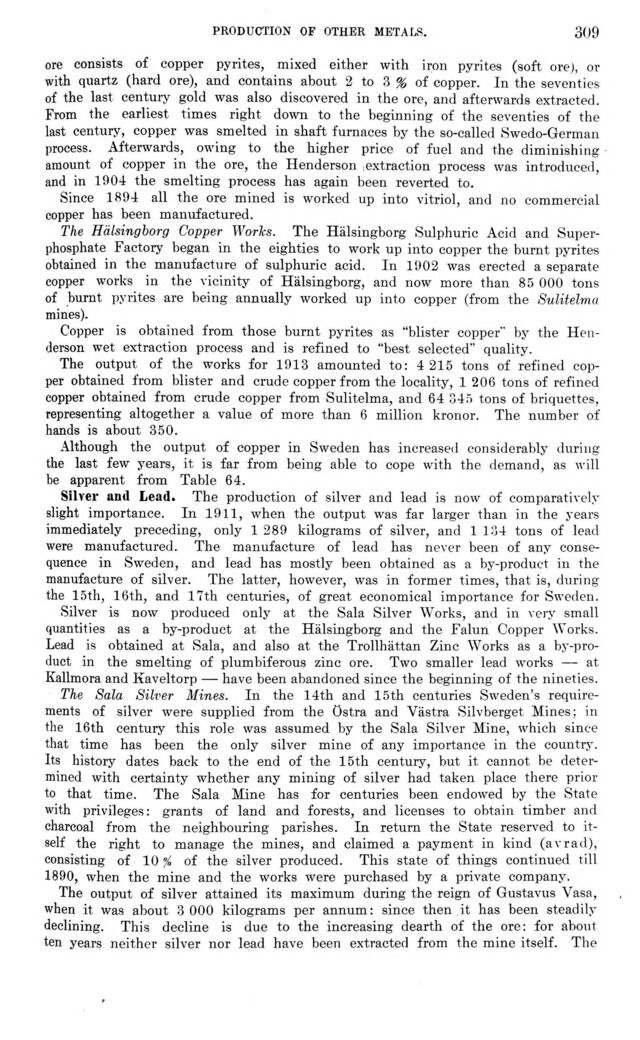
Full resolution (JPEG) - On this page / på denna sida - VI. Mining and Metallurgical Industry. General Survey. By C. Sahlin - 3. Production of other Metals. By J. G. Petrén

<< prev. page << föreg. sida << >> nästa sida >> next page >>
Below is the raw OCR text
from the above scanned image.
Do you see an error? Proofread the page now!
Här nedan syns maskintolkade texten från faksimilbilden ovan.
Ser du något fel? Korrekturläs sidan nu!
This page has never been proofread. / Denna sida har aldrig korrekturlästs.
production of other metals.
309
ore consists of copper pyrites, mixed either with iron pyrites (soft ore), or
with quartz (hard ore), and contains about 2 to 3 % of copper. In the seventies
of the last century gold was also discovered in the ore, and afterwards extracted.
From the earliest times right down to the beginning of the seventies of the
last century, copper was smelted in shaft furnaces by the so-called Swedo-Gerrnan
process. Afterwards, owing to the higher price of fuel and the diminishing
amount of copper in the ore, the Henderson extraction process was introduced,
and in 1904 the smelting process has again been reverted to.
Since 1894 all the ore mined is worked up into vitriol, and no commercial
copper has been manufactured.
The Hälsingborg Copper Works. The Hälsingborg Sulphuric Acid and
Superphosphate Factory began in the eighties to work up into copper the burnt pyrites
obtained in the manufacture of sulphuric acid. In 1902 was erected a separate
copper works in the vicinity of Hälsingborg, and now more than 85 000 tons
of burnt pyrites are being annually worked up into copper (from the Sulitelma
mines).
Copper is obtained from those burnt pyrites as "blister copper" by the
Henderson wet extraction process and is refined to "best selected" quality.
The output of the works for 1913 amounted to: 4 215 tons of refined
copper obtained from blister and crude copper from the locality, 1 206 tons of refined
copper obtained from crude copper from Sulitelma, and 64 345 tons of briquettes,
representing altogether a value of more than 6 million kronor. The number of
hands is about 350.
Although the output of copper in Sweden has increased considerably during
the last few years, it is far from being able to cope with the demand, as will
be apparent from Table 64.
Silver an<l Lead. The production of silver and lead is now of comparatively
slight importance. In 1911, when the output was far larger than in the years
immediately preceding, only 1 289 kilograms of silver, and 1 134 tons of lead
were manufactured. The manufacture of lead has never been of any
consequence in Sweden, and lead has mostly been obtained as a by-product in the
manufacture of silver. The latter, however, was in former times, that is, during
the 15th, 16th, and 17th centuries, of great economical importance for Sweden.
Silver is now produced only at the Sala Silver Works, and in very small
quantities as a by-product at the Hälsingborg and the Falun Copper Works.
Lead is obtained at Sala, and also at the Trollhättan Zinc Works as a
by-product in the smelting of plumbiferous zinc ore. Two smaller lead works — at
Kallmora and Iiaveltorp — have been abandoned since the beginning of the nineties.
The Sala Silver Mines. In the 14th and 15th centuries Sweden’s
requirements of silver were supplied from the östra and Västra Silvberget Mines; in
the 16th century this role was assumed by the Sala Silver Mine, which since
that time has been the only silver mine of any importance in the country.
Its history dates back to the end of the 15th century, but it cannot be
determined with certainty whether any mining of silver had taken place there prior
to that time. The Sala Mine has for centuries been endowed by the State
with privileges: grants of land and forests, and licenses to obtain timber and
charcoal from the neighbouring parishes. In return the State reserved to
itself the right to manage the mines, and claimed a payment in kind (a v rad),
consisting of 10 % of the silver produced. This state of things continued till
1890, when the mine and the works were purchased by a private company.
The output of silver attained its maximum during the reign of Gustavus Vasa,
when it was about 3 000 kilograms per annum: since then .it has been steadily
declining. This decline is due to the increasing dearth of the ore: for about
ten years neither silver nor lead have been extracted from the mine itself. The
<< prev. page << föreg. sida << >> nästa sida >> next page >>